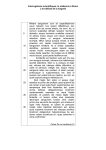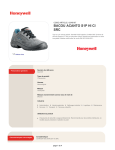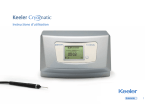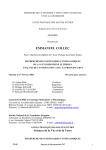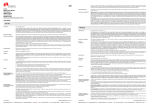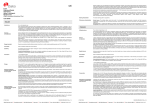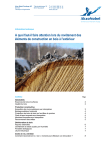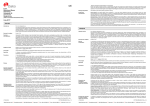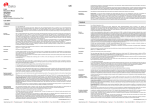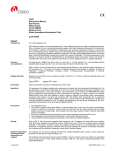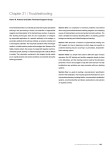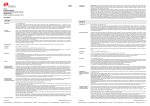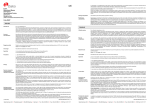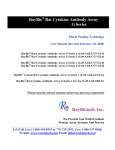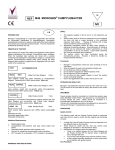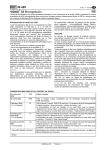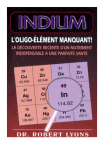Download FLEX Monoclonal Mouse Anti-Vimentin Clone V9 Ready-to
Transcript
should include tonsil and liver and the cells/structures should display reaction patterns as described for this tissue in “Performance characteristics” in all positive specimens. The recommended negative control reagent is FLEX Negative Control, Mouse (Dako Autostainer/Autostainer Plus) (Code IS750). FLEX Monoclonal Mouse Anti-Vimentin Clone V9 Ready-to-Use (Dako Autostainer/Autostainer Plus) Staining interpretation The cellular staining pattern is cytoplasmic. Performance characteristics Normal tissues: In general, most human mesenchymal cells are labeled by the antibody, including fibrocytes, lipocytes, smooth muscle cells, vascular endothelial cells, astrocytes, peripheral nerve (Schwann) cells, macrophages (including Kupffer cells), as well as myoepithelial cells of sweat and salivary glands and of breast, which are all labeled strongly. Also positive, with variable intensity and distribution, are the follicular cells of the thyroid, adrenal cortex, renal distal tubules, and mesangial and endothelial cells of the renal glomerulus, as well as pancreatic acinar cells (1, 3). In the human eye, the antibody labels the pigmented posterior and the anterior epithelia of the human iris, including the muscle portion (dilator pupillae) of the anterior epithelium, as well as the nonpigmented and pigmented ciliary epithelia (5). In the ciliary epithelia, vimentin was coexpressed with cytokeratin (5). Skeletal and cardiac muscle cells, epidermal, squamous, urothelial, colonic and gastric mucosal, and glial cells, as well as neurons are consistently negative with the antibody (1, 3). Abnormal tissues: The antibody labeled 17/20 sarcomas, 16/18 melanomas, 4/4 meningeomas, and 3/3 schwannomas, and was the sole intermediate filament present in these tumors. In addition, variable percentages (10-57%) of carcinomas, neuroendocrine carcinomas, neuroblastomas, thymomas and mesotheliomas were positive with the antibody. With the exception of the neuroblastomas, cytokeratin was coexpressed with vimentin in these tumors. Among adenocarcinomas, more than 50% of papillary carcinomas of the thyroid as well as renal, endometrial, ovarian and lung carcinomas were labeled by the antibody and coexpressed keratins and vimentin (1). Code IS630 ENGLISH Intended use For in vitro diagnostic use. FLEX Monoclonal Mouse Anti-Vimentin, Clone V9, Ready-to-Use, (Dako Autostainer/Autostainer Plus), is intended for use in immunohistochemistry together with Dako Autostainer/Autostainer Plus instruments. This antibody is useful for the identification of cells of mesenchymal origin in normal and neoplastic tissues, and is of value in tumor diagnosis. The clinical interpretation of any staining or its absence should be complemented by morphological studies using proper controls and should be evaluated within the context of the patient's clinical history and other diagnostic tests by a qualified pathologist. Summary and explanation Vimentin is a 57 kDa intermediate filament (IF) protein, which form part of the cytoskeleton of vertebrate cells. Among the five classes* of IFs, comprising nine groups, vimentin belongs to class III, showing a high degree of specificity for cells of mesenchymal origin. The cell type specificity, displayed by each of the IF subtypes, was initially thought to be retained in malignant cells as well as their normal counterpart, which made IFs important as diagnostic markers in histogenesis. The coexpression of intermediate filaments, particularly vimentin and cytokeratin, has now been demonstrated in a variety of normal cells/tissues and in neoplastic lesions, necessitating the use of a panel of antibodies in differential tumor diagnosis (2). Refer to Dako’s General Instructions for Immunohistochemical Staining or the detection system instructions of IHC procedures for: 1) Principle of Procedure, 2) Materials Required, Not Supplied, 3) Storage, 4) Specimen Preparation, 5) Staining Procedure, 6) Quality Control, 7) Troubleshooting, 8) Interpretation of Staining, 9) General Limitations. Reagent provided Ready-to-use monoclonal mouse antibody provided in liquid form in a buffer containing stabilizing protein and 0.015 mol/L NaN3. Clone: V9 Isotype: Ig1, kappa. Immunogen Purifi ed vimentin from porcine eye lens (3). Specificity In Western blotting of purified porcine vimentin, the antibody labels a single band of 57 kDa corresponding to vimentin. When applying whole cell extracts of cell lines expressing vimentin plus glial fibrillary acidic protein (GFAP), and vimentin plus desmin, respectively, the antibody labels specifically the 57 kDa vimentin band. As directly shown by these experiments, the antibody does not react with the two IF proteins most closely related to vimentin, i.e. desmin and GFAP (3). In immunocytochemistry the antibody labels the vimentin-positive human cell lines IMR90, RD, glioma and HeLa (3). Precautions 1. For professional users. 2. This product contains sodium azide (NaN3), a chemical highly toxic in pure form. At product concentrations, though not classified as hazardous, sodium azide may react with lead and copper plumbing to form highly explosive build-ups of metal azides. Upon disposal, flush with large volumes of water to prevent metal azide build-up in plumbing. 3. As with any product derived from biological sources, proper handling procedures should be used. 4. Wear appropriate Personal Protective Equipment to avoid contact with eyes and skin. 5. Unused solution should be disposed of according to local, State and Federal regulations. Storage Store at 2-8 °C. Do not use after expiration date sta mped on vial. If reagents are stored under any conditions other than those specified, the conditions must be verified by the user. There are no obvious signs to indicate instability of this product. Therefore, positive and negative controls should be run simultaneously with patient specimens. If unexpected staining is observed which cannot be explained by variations in laboratory procedures and a problem with the antibody is suspected, contact Dako Technical Support. Specimen preparation including materials required but not supplied Staining procedure including materials required but not supplied The antibody can be used for labeling formalin-fixed, paraffin-embedded tissue sections. Tissue specimens should be cut into sections of approximately 4 µm. Pre-treatment with heat-induced epitope retrieval (HIER) is required using Dako PT Link (Code PT100/PT101). For details, please refer to the PT Link User Guide. Optimal results are obtained by pretreating tissues using EnVision FLEX Target Retrieval Solution, High pH (50x) (Code K8010/K8004). Paraffin-embedded sections: Pre-treatment of formalin-fixed, paraffin-embedded tissue sections is recommended using the 3-in-1 specimen preparation procedure for Dako PT Link. Follow the pre-treatment procedure outlined in the package insert for EnVision FLEX Target Retrieval Solution, High pH (50x) (Code K8010/K8004). Note: After staining the sections must be dehydrated, cleared and mounted using permanent mounting medium. Deparaffinized sections: Pre-treatment of deparaffinized formalin-fixed, paraffin-embedded tissue sections is recommended using Dako PT Link and following the same procedure as described for paraffin-embedded sections. After staining the slides should be mounted using aqueous or permanent mounting medium. The tissue sections should not dry out during the treatment or during the following immunohistochemical staining procedure. For greater adherence of tissue sections to glass slides, the use of FLEX IHC Microscope Slides (Code K8020) is recommended. FRANÇAIS Utilisation prévue Pour utilisation diagnostique in vitro. FLEX Monoclonal Mouse Anti-Vimentin, Clone V9, Ready-to-Use, (Dako Autostainer/Autostainer Plus) est destiné à une utilisation en immunohistochimie avec les instruments Dako Autostainer/Autostainer Plus. Cet anticorps facilite l’identification des cellules d’origine mésenchymateuse dans les tissus sains et néoplasiques et est utile pour le diagnostic des tumeurs. L’interprétation clinique de toute coloration ou son absence doit être complétée par des études morphologiques en utilisant des contrôles appropriés et doit être évaluée en fonction des antécédents cliniques du patient et d’autres tests diagnostiques par un pathologiste qualifié. Résumé et explication La vimentine est une protéine de filament intermédiaire (FI) de 57 kDa, qui constitue le cytosquelette des cellules vertébrées. Parmi les cinq classes* de FI, qui regroupent neuf groupes, la vimentine appartient à la classe III, ce qui indique un degré élevé de spécificité pour les cellules d’origine mésenchymateuse. On pensait au départ que la spécificité pour le type de cellule, indiquée par chaque sous-type de FI, était retenue dans les cellules tumorales ainsi que dans leurs homologues normales, ce qui faisait des FI d’importants marqueurs de diagnostic en termes d’histogenèse. La co-expression de filaments intermédiaires, notamment la vimentine et la cytokératine, a désormais été démontrée dans diverses cellules normales/tissus sains et dans des lésions néoplasiques, ce qui implique d’utiliser un panel d’anticorps pour le diagnostic différentiel des tumeurs (2). Se référer aux Instructions générales de coloration immunohistochimique de Dako ou aux instructions du système de détection relatives aux procédures IHC pour plus d’informations concernant les points suivants : 1) Principe de procédure, 2) Matériels requis mais non fournis, 3) Conservation, 4) Préparation des échantillons, 5) Procédure de coloration, 6) Contrôle qualité, 7) Dépannage, 8) Interprétation de la coloration, 9) Limites générales. Réactifs fournis Anticorps monoclonal de souris prêt à l’emploi fourni sous forme liquide dans un tampon contenant une protéine stabilisante et 0,015 mol/L d’azide de sodium. Clone : V9 Isotype : Ig1, kappa. Immunogène Vimentine de cristallin de porc purifiée (3). Spécificité Dans les analyses par Western blot de vimentine de porc purifiée, l’anticorps marque une seule bande de 57 kDa correspondant à la vimentine. Lors de l’application d’extraits cellulaires entiers de lignées cellulaires exprimant la vimentine plus la protéine gliofibrillaire acide (PGFA), et la vimentine plus la desmine, respectivement, l’anticorps marque spécifiquement une bande de vimentine de 57 kDa. Comme l’indiquent de manière directe ces expériences, l’anticorps ne réagit pas aux deux protéines FI les plus étroitement apparentées à la vimentine, à savoir la desmine et la PGFA (3). En immunocytochimie, l’anticorps marque les lignées cellulaires humaines IMR90, RD, gliome et HeLa positives à la vimentine (3). Précautions 1. Pour utilisateurs professionnels. 2. Ce produit contient de l’azide de sodium (NaN3), produit chimique hautement toxique dans sa forme pure. Aux concentrations du produit, bien que non classé comme dangereux, l’azide de sodium peut réagir avec le cuivre et le plomb des canalisations et former des accumulations d’azides métalliques hautement explosifs. Lors de l’élimination, rincer abondamment à l’eau pour éviter toute accumulation d’azide métallique dans les canalisations. 3. Comme avec tout produit d’origine biologique, des procédures de manipulation appropriées doivent être respectées. 4. Porter un vêtement de protection approprié pour éviter le contact avec les yeux et la peau. 5. Les solutions non utilisées doivent être éliminées conformément aux réglementations locales et nationales. Conservation Conserver entre 2 et 8 °C. Ne pas utiliser après la date de péremption indiquée sur le flacon. Si les réactifs sont conservés dans des conditions autres que celles indiquées, celles-ci doivent être validées par l’utilisateur. Il n’y a aucun signe évident indiquant l’instabilité de ce produit. Par conséquent, des contrôles positifs et négatifs doivent être testés en même temps que les échantillons de patient. Si une coloration inattendue est observée, qui ne peut être expliquée par un changement des procédures du laboratoire, et en cas de suspicion d’un problème lié à l’anticorps, contacter l’assistance technique de Dako. Préparation des échantillons y compris le matériel requis mais non fourni L’anticorps peut être utilisé pour le marquage des coupes de tissus inclus en paraffine et fixés au formol. L’épaisseur des coupes d’échantillons de tissu doit être d’environ 4 µm. Un prétraitement avec démasquage d’épitope induit par la chaleur (HIER) est nécessaire avec le Dako PT Link (Réf. PT100/PT101). Pour plus de détails, se référer au Guide d’utilisation du PT Link. Des résultats optimaux sont obtenus en prétraitant les tissus à l’aide de la EnVision FLEX Target Retrieval Solution, High pH (50x) (Réf. K8010/K8004). Coupes incluses en paraffine : le prétraitement des coupes tissulaires fixées au formol et incluses en paraffine est recommandé à l'aide de la procédure de préparation d'échantillon 3-en-un pour le Dako PT Link. Suivre la procédure de prétraitement indiquée dans la notice de la EnVision FLEX Target Retrieval Solution, High pH (50x) (Réf. K8010/K8004). Remarque : après coloration, les coupes doivent être déshydratées, lavées et montées à l’aide d’un milieu de montage permanent. Coupes déparaffinées : le prétraitement des coupes tissulaires déparaffinées, fixées au formol et incluses en paraffine, est recommandé à l’aide du Dako PT Link, en suivant la même procédure que pour les coupes incluses en paraffine. Après coloration, un montage aqueux ou permanent des lames est recommandé. Les coupes de tissus ne doivent pas sécher lors du traitement ni lors de la procédure de coloration immunohistochimique suivante. Pour une meilleure adhérence des coupes de tissus sur les lames de verre, il est recommandé d’utiliser des lames FLEX IHC Microscope Slides (Réf. K8020). The recommended visualization system is EnVision FLEX, High pH (Dako Autostainer/Autostainer Plus) (Code K8010). The staining steps and incubation times are pre-programmed into the software of Dako Autostainer/Autostainer Plus instruments, using the following protocols: Template protocol: FLEXRTU2 (200 µL dispense volume) or FLEXRTU3 (300 µL dispense volume) Autoprogram: VimV9 (without counterstaining) or VimV9H (with counterstaining) The Auxiliary step should be set to “rinse buffer” in staining runs with ≤10 slides. For staining runs with >10 slides the Auxiliary step should be set to “none”. This ascertains comparable wash times. All incubation steps should be performed at room temperature. For details, please refer to the Operator’s Manual for the dedicated instrument. If the protocols are not available on the used Dako Autostainer platform, please contact Dako Technical Services. Optimal conditions may vary depending on specimen and preparation methods, and should be determined by each individual laboratory. If the evaluating pathologist should desire a different staining intensity, a Dako Application Specialist/Technical Service Specialist can be contacted for information on re-programming of the protocol. Verify that the performance of the adjusted protocol is still valid by evaluating that the staining pattern is identical to the staining pattern described in “Performance characteristics”. (115275-002) Dako Denmark A/S Counterstaining in hematoxylin is recommended using EnVision FLEX Hematoxylin (Dako Autostainer/Autostainer Plus) (Code K8018). Non-aqueous, permanent mounting medium is recommended. Positive and negative controls should be run simultaneously using the same protocol as the patient specimens. The positive control tissue IS630/EFG/MNI/2009.12.04 p. 1/4 | Produktionsvej 42 | DK-2600 Glostrup | Denmark | Tel. +45 44 85 95 00 | Fax +45 44 85 95 95 | CVR No. 33 21 13 17 (115275-002) Dako Denmark A/S IS630/EFG/MNI/2009.12.04 p. 2/4 | Produktionsvej 42 | DK-2600 Glostrup | Denmark | Tel. +45 44 85 95 00 | Fax +45 44 85 95 95 | CVR No. 33 21 13 17 Procédure de coloration y compris le matériel requis mais non fourni Le système de visualisation recommandé est le EnVision FLEX, High pH, (Dako Autostainer/Autostainer Plus) (Réf. K8010). Les étapes de coloration et d’incubation sont préprogrammées dans le logiciel des instruments Dako Autostainer/Autostainer Plus, à l’aide des protocoles suivants : Protocole modèle : FLEXRTU2 (volume de distribution de 200 µL) ou FLEXRTU3 (volume de distribution de 300 µL) Autoprogram : VimV9 (sans contre-coloration) ou VimV9H (avec contre-coloration) Vorbereitung der Probe und erforderliche, aber nicht mitgelieferte Materialien Der Antikörper eignet sich zur Markierung von formalinfixierten und paraffineingebetteten Gewebeschnitten. Gewebeproben sollten in Schnitte von ca. 4 µm Stärke geschnitten werden. Die Vorbehandlung durch hitzeinduzierte Epitopdemaskierung (HIER) mit Dako PT Link (Code-Nr. PT100/PT101) ist erforderlich. Weitere Informationen hierzu siehe PT Link-Benutzerhandbuch. Optimale Ergebnisse können durch Vorbehandlung der Gewebe mit EnVision FLEX Target Retrieval Solution, High pH (50x) (Code-Nr. K8010/K8004) erzielt werden. Paraffineingebettete Schnitte: Die Vorbehandlung der formalinfixierten, paraffineingebetteten Schnitte mit dem 3-in-1Probenvorbereitungsverfahren für Dako PT Link wird empfohlen. Vorbehandlung gemäß der Beschreibung in der Packungsbeilage für EnVision FLEX Target Retrieval Solution, High pH (50x) (Code-Nr. K8010/K8004) durchführen. Hinweis: Nach dem Färben müssen die Schnitte dehydriert, geklärt und mit permanentem Einbettmedium auf den Objektträger aufgebracht werden. Entparaffinierte Schnitte: Eine Vorbehandlung der entparaffinierten, formalinfixierten, paraffineingebetteten Gewebeschnitte mit Dako PT Link nach demselben Verfahren, wie für die paraffineingebetteten Schnitte beschrieben, wird empfohlen. Die Objektträger nach dem Färben mit einem wässrigen oder permanenten Einbettmedium bedecken. Die Gewebeschnitte dürfen während der Behandlung oder des anschließenden immunhistochemischen Färbeverfahrens nicht austrocknen. Zur besseren Haftung der Gewebeschnitte an den Glasobjektträgern wird die Verwendung von FLEX IHC Microscope Slides (Code-Nr. K8020) empfohlen. Färbeverfahren und erforderliche, aber nicht mitgelieferte Materialien Das empfohlene Visualisierungssystem ist EnVision™ FLEX, High pH (Dako Autostainer/Autostainer Plus) (Code-Nr. K8010). Die Färbeschritte und Inkubationszeiten sind in der Software der Dako Autostainer/Autostainer Plus-Geräte mit den folgenden Protokollen vorprogrammiert: Matrix-Protokoll: FLEXRTU2 (200 µL Abgabevolumen) oder FLEXRTU3 (300 µL Abgabevolumen) Autoprogram: VimV9 (ohne Gegenfärbung) oder VimV9H (mit Gegenfärbung) Bei Färbedurchläufen mit höchstens 10 Objektträgern sollte der „Zusatz“-Schritt auf „Pufferspülgang“ eingestellt werden. Für Färbedurchläufe mit mehr als 10 Objektträgern den „Zusatz“-Schritt auf „Keine“ einstellen. Dieses gewährleistet vergleichbare Waschzeiten. Alle Inkubationsschritte sollten bei Raumtemperatur durchgeführt werden. Nähere Einzelheiten bitte dem Benutzerhandbuch für das jeweilige Gerät entnehmen. Wenn die Färbeprotokolle auf dem verwendeten Dako Autostainer-Gerät nicht verfügbar sind, bitte den Technischen Kundendienst von Dako verständigen. Optimale Bedingungen können je nach Probe und Präparationsverfahren unterschiedlich sein und sollten vom jeweiligen Labor selbst ermittelt werden. Falls der beurteilende Pathologe eine andere Färbungsintensität wünscht, kann ein Anwendungsspezialist oder Kundendiensttechniker von Dako bei der Neuprogrammierung des Protokolls helfen. Die Leistung des angepassten Protokolls muss verifiziert werden, indem gewährleistet wird, dass das Färbemuster mit dem unter „Leistungsmerkmale“ beschriebenen Färbemuster identisch ist. Die Gegenfärbung in Hämatoxylin sollte mit EnVision™ FLEX Hematoxylin, (Dako Autostainer/Autostainer Plus) (Code-Nr. K8018) ausgeführt werden. Empfohlen wird ein nichtwässriges, permanentes Fixiermittel. Positiv- und Negativkontrollen sollten zur gleichen Zeit und mit demselben Protokoll wie die Patientenproben getestet werden. Das positive Kontrollgewebe sollte Mandel- und Lebergewebe enthalten und die Zellen/Strukturen müssen in allen positiven Proben die für dieses Gewebe unter „Leistungsmerkmale“ beschriebenen Reaktionsmuster aufweisen. Das empfohlene Negativ-Kontrollreagenz ist FLEX Negative Control, Mouse (Dako Autostainer/Autostainer Plus) (Code-Nr. IS750). Auswertung der Färbung Das zelluläre Färbemuster ist zytoplasmatisch. Leistungsmerkmale Gesundes Gewebe: Im Allgemeinen markierte der Antikörper die meisten menschlichen Mesenchymzellen, einschließlich Fibrozyten, Lipozyten, Zellen aus glatter Muskulatur, vaskuläre Endothelzellen, Astrozyten, periphere Nervenzellen, Makrophagen (auch Kupffer-Zellen) sowie Myoepithelzellen aus Schweiß- und Speicheldrüsen und von der Brust, sie allesamt stark markiert wurden. Ebenfalls positiv wurden – mit variabler Intensität und Verteilung – Follikelzellen der Schilddrüse, Nebennierenrinde und der distalen Nierenkanäle sowie Mesangialund Endothelzellen des Nierenglomerulus und Azinuszellen des Pankreas (1, 3). Im menschlichen Auge markiert der Antikörper die pigmentierten posterioren und anterioren Epithelien der Iris, einschließlich der Muskelportion der anterioren Epithelien (Pupillenerweiterer) und der pigmentierten und nicht pigmentierten Epithelien (5). In den Ziliarkörperepithelien wurde Vimentin mit Zytokeratin koexprimiert (5). Skelettmuskel- und Herzmuskelzellen, Plattenepithelzellen, Urothelzellen, Gliazellen, Neuronen sowie Zellen der Epidermis, des Dickdarms und der Magenschleimhaut reagieren durchgängig negativ auf den Antikörper (1, 3). Pathologisches Gewebe: Der Antikörper markierte 17 von 20 Sarkomen, 16 von 18 Melanomen, 4 von 4 Meningiomen und 3 von 3 Schwannomen und war das einzige intermediäre Filamentprotein in diesen Tumoren. Zusätzlich reagierten unterschiedliche Anteile (10– 57 %) von Karzinomen, neuroendokrinen Karzinomen, Neuroblastomen, Thymomen und Mesotheliomen positiv auf den Antikörper. Mit Ausnahme der Neuroblastome wurde Zytokeratin mit Vimentin in diesen Tumoren koexprimiert. Unter den Adenokarzinomen wurden mehr als 50 % der Papillenkarzinome der Schilddrüse sowie Karzinome der Nieren, des Endometriums, der Eierstöcke und der Lunge durch den Antikörper markiert. Zudem haben sie Keratine und Vimentin koexprimiert (1). L’étape Auxiliary doit être réglée sur « rinse buffer » lors des cycles de coloration avec ≤10 lames. Pour les cycles de coloration de >10 lames, l’étape Auxiliary doit être réglée sur « none ». Cela garantit des temps de lavage comparables. Toutes les étapes d’incubation doivent être effectuées à température ambiante. Pour plus de détails, se référer au Manuel de l’opérateur spécifique à l'instrument. Si les protocoles ne sont pas disponibles sur la plateforme Dako Autostainer utilisée, contacter le service technique de Dako. Les conditions optimales peuvent varier en fonction du prélèvement et des méthodes de préparation, et doivent être déterminées par chaque laboratoire individuellement. Si le pathologiste qui réalise l’évaluation désire une intensité de coloration différente, un spécialiste d’application/spécialiste du service technique de Dako peut être contacté pour obtenir des informations sur la re-programmation du protocole. Vérifier que l'exécution du protocole modifié est toujours valide en vérifiant que le schéma de coloration est identique au schéma de coloration décrit dans les « Caractéristiques de performance ». Il est recommandé d’effectuer une contre-coloration à l’aide de EnVision FLEX Hematoxylin (Dako Autostainer/Autostainer Plus) (Réf. K8018). L’utilisation d’un milieu de montage permanent non aqueux est recommandée. Des contrôles positifs et négatifs doivent être réalisés en même temps et avec le même protocole que les échantillons du patient. Le contrôle de tissu positif doit comprendre le foie et l’amygdale et les cellules/structures doivent présenter des schémas de réaction tels que décrits pour ces tissus dans les « Caractéristiques de performance » pour tous les échantillons positifs. Le contrôle négatif recommandé est le FLEX Negative Control, Mouse, (Dako Autostainer/Autostainer Plus) (Réf. IS750). Interprétation de la coloration Le schéma de coloration cellulaire est cytoplasmique. Caractéristiques de performance Tissus sains : En général, la plupart des cellules mésenchymateuses humaines sont marquées par l’anticorps, y compris les fibrocytes, les lipocytes, les cellules du muscle lisse, les cellules endothéliales vasculaires, les astrocytes, les cellules du nerf périphérique (Schwann), les macrophages (y compris les cellules de Kupffer), ainsi que les cellules myoépithéliales du sein et des glandes sudoripares et salivaires, qui sont toutes fortement marquées. Autres matériaux également positifs, avec une intensité et une répartition variables : les cellules folliculaires de la thyroïde, le cortex surrénal, les tubules rénaux distaux, et les cellules mésangiales et endothéliales du glomérule rénal, ainsi que les cellules acinaires du pancréas (1, 3). Dans l’œil humain, l’anticorps marque les épithéliums antérieur et postérieur pigmentés de l’iris humain, notamment la partie musculaire (muscle dilatateur de la pupille) de l’épithélium antérieur, ainsi que les épithéliums ciliaires pigmentés et non pigmentés (4). Dans les épithéliums ciliaires, la vimentine était co-exprimée avec la cytokératine (4). Les cellules des muscles squelettique et cardiaque, les cellules épidermiques, squameuses, urothéliales, de la muqueuse gastrique et du côlon, les cellules gliales, ainsi que les neurones sont systématiquement négatifs à l’anticorps (1, 3). Tissus tumoraux : L’anticorps marque 17 sarcomes sur 20, 16 mélanomes sur 18, 4 méningiomes sur 4 et 3 schwannomes sur 3, et était le seul filament intermédiaire présent dans ces tumeurs. En outre, des pourcentages variables (10–57 %) de carcinomes, de carcinomes neuroendocrines, de neuroblastomes, de thymomes et de mésothéliomes étaient positifs à l’anticorps. À l’exception des neuroblastomes, la cytokératine était co-exprimée avec la vimentine dans ces tumeurs. Parmi les adénocarcinomes, plus de 50 % de carcinomes papillaires de la thyroïde ainsi que des carcinomes du rein, de l’endomètre, de l’ovaire et du poumon étaient marqués par l’anticorps et co-exprimaient des kératines et la vimentine (1). DEUTSCH Zweckbestimmung Zur In-vitro-Diagnostik. FLEX Monoclonal Mouse Anti-Vimentin, Clone V9, Ready-to-Use, (Dako Autostainer/Autostainer Plus) ist zur Verwendung in der Immunhistochemie in Verbindung mit Dako Autostainer/Autostainer Plus-Geräten bestimmt. Dieser Antikörper dient zum Nachweis von Zellen mesenchymalen Ursprungs in gesundem und neoplastischem Gewebe und ist nützlich bei der Tumordiagnose. Die klinische Auswertung einer eventuell eintretenden Färbung sollte durch morphologische Studien mit geeigneten Kontrollen ergänzt werden und von einem qualifizierten Pathologen unter Berücksichtigung der Krankengeschichte und anderer diagnostischer Tests des Patienten vorgenommen werden. Zusammenfassung und Erklärung Vimentin ist ein 57 kDa schweres intermediäres Filamentprotein (IF), das einen Teil des Zytoskeletts von Wirbeltierzellen bildet. Vimentin gehört zur Klasse III der fünf Klassen* von IFs, die jeweils neun Gruppen umfassen. Es zeigt eine hohe Spezifität für Zellen mesenchymaler Abstammung. Zunächst hatte man angenommen, die von jeder IF-Unterart gezeigte Zellentyp-Spezifität in gesunden Zellen bleibe in malignen Zellen erhalten. Damit wären IFs wichtige diagnostische Marker für die Histogenese gewesen. Die Koexpression intermediärer Filamentproteine, insbesondere von Vimentin und Zytokeratin, wurde inzwischen in einer Reihe von gesunden Zellen/Geweben und in neoplastischen Läsionen nachgewiesen, was für die Differenzialdiagnose von Tumoren eine ganze Reihe von Antikörpertests erforderlich macht (2). Folgende Angaben bitte den Allgemeinen Richtlinien zur immunhistochemischen Färbung von Dako oder den Anweisungen des Detektionssystems für IHC-Verfahren entnehmen: 1) Verfahrensprinzip, 2) Erforderliche, aber nicht mitgelieferte Materialien, 3) Aufbewahrung, 4) Vorbereitung der Probe, 5) Färbeverfahren, 6) Qualitätskontrolle, 7) Fehlersuche und -behebung, 8) Auswertung der Färbung, 9) Allgemeine Beschränkungen. Gebrauchsfertiger, monoklonaler Maus-Antikörper in flüssiger Form in einem Puffer, der stabilisierendes Protein und 0,015 mol/L NaN3 enthält. Klon: V9 Isotyp: Ig1, Kappa. Geliefertes Reagenz Immunogen Gereinigtes Vimentin aus der Augenlinse vom Schwein (3). Spezifität Beim Western-Blotting von gereinigtem Schweine-Vimentin markiert der Antikörper eine einzige Vimentin entsprechende Bande von 57 kDa. Bei Verwendung von Vollextrakten Vimentin-exprimierender Zelllinien plus GFAP (fibrilläres saures Gliaprotein) und Vimentin bzw. Vimentin plus Desmin markiert der Antikörper spezifisch die 57-kDa-Vimentinbande. Diese Versuche beweisen unmittelbar, dass der Antikörper nicht mit den beiden IF-Proteinen reagiert, die Vimentin am nächsten verwandt sind, also Desmin und GFAP (3). Bei der Immunzytochemie markiert der Antikörper die Vimentin-positiven menschlichen Zelllinien IMR90, RD, Glioma und HeLa (3). Vorsichtsmaßnahmen Lagerung (115275-002) Dako Denmark A/S References/ Références/ Literatur 1. Azumi N, Battifora H. The distribution of vimentin and keratin in epithelial and nonepithelial neoplasms. Am J Clin Pathol 1987;88:286-96. 2. Herrmann H, Aebi U. Intermediate filaments and their associates: multi-talented structural elements specifying cytoarchitecture and cytodynamics. Curr Opin Cell Biol 2000;12:79-90. 3. Osborn M, Debus E, Weber K. Monoclonal antibodies specific for vimentin. Eur J Cell Biol 1984;34:137-43. 4. Bohn W, Wiegers W, Beuttenmüller M, Traub P. Species-specific recognition patterns of monoclonal antibodies directed against vimentin. Exp Cell Res 1992;201:1-7. 5. Kivelä T, Fuchs U, Tarkkanen A. Cytoskeleton in neuroectodermally derived epithelial and muscle cells of the human iris and ciliary body. J Histochem Cytochem 1992;40:1517-26. Explanation of symbols/ Explication des symboles/ Erläuterung der Symbole 1. Nur für Fachpersonal bestimmt. 2. Dieses Produkt enthält Natriumazid (NaN3), eine in reiner Form äußerst giftige Chemikalie. Natriumazid kann auch in als ungefährlich eingestuften Konzentrationen mit Blei- und Kupferrohren reagieren und hochexplosive Metallazide bilden. Nach der Entsorgung stets mit viel Wasser nachspülen, um Metallazidansammlungen in den Leitungen vorzubeugen. 3. Wie alle Produkte biologischen Ursprungs müssen auch diese entsprechend gehandhabt werden. 4. Geeignete Schutzkleidung tragen, um Augen- und Hautkontakt zu vermeiden. 5. Nicht verwendete Lösung ist entsprechend örtlichen, bundesstaatlichen und staatlichen Richtlinien zu entsorgen. Catalogue number Référence catalogue Bestellnummer Temperature limitation Limites de température Use by Utiliser avant Zulässiger Temperaturbereich Verwendbar bis In vitro diagnostic medical device Dispositif médical de diagnostic in vitro In-vitro-Diagnostikum Contains sufficient for <n> tests Contenu suffisant pour <n> tests Manufacturer Fabricant Inhalt ausreichend für <n> Tests Hersteller Consult instructions for use Voir les instructions d’utilisation Gebrauchsanweisung beachten Batch code Numéro de lot Chargenbezeichnung Bei 2–8 °C aufbewahren. Nach Ablauf des auf dem Fläsch chen aufgedruckten Verfalldatums nicht mehr verwenden. Werden die Reagenzien unter anderen als den angegebenen Bedingungen aufbewahrt, müssen diese Bedingungen vom Benutzer validiert werden. Es gibt keine offensichtlichen Anzeichen für eine eventuelle Produktinstabilität. Positiv- und Negativkontrollen sollten daher zur gleichen Zeit wie die Patientenproben getestet werden. Falls es zu einer unerwarteten Färbung kommt, die sich nicht durch Unterschiede bei Laborverfahren erklären lässt und auf ein Problem mit dem Antikörper hindeutet, ist der technische Kundendienst von Dako zu verständigen. IS630/EFG/MNI/2009.12.04 p. 3/4 | Produktionsvej 42 | DK-2600 Glostrup | Denmark | Tel. +45 44 85 95 00 | Fax +45 44 85 95 95 | CVR No. 33 21 13 17 (115275-002) Dako Denmark A/S IS630/EFG/MNI/2009.12.04 p. 4/4 | Produktionsvej 42 | DK-2600 Glostrup | Denmark | Tel. +45 44 85 95 00 | Fax +45 44 85 95 95 | CVR No. 33 21 13 17


